Murano Lamp Mushroom Glass 60s Modernist Sputnik Vintage Venini Vistosi Stilnovo
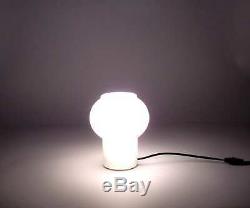
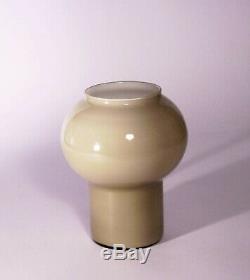
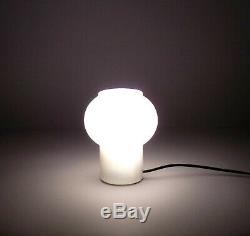
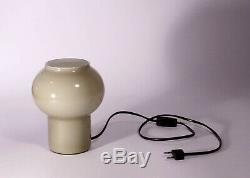
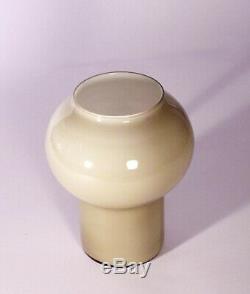
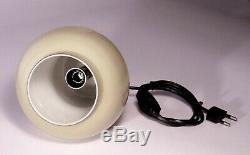

Vintage Murano Glass Mushroom Table Lamp Italy, 1960s. Mushroom "Fungo" Lamp, made in Italy, circa 1960s.
Mid-Century Modern "mushroom" shaped table lamp, executed in hand blown Murano glass with the "Incamiciato" technique, in the Style of Massimo Vignelli for Venini, made in Italy, circa 1960s. Place of Origin: Italy Maker:??? (VISTOSI / V ENINI) Designer:??? (Massimo Vignelli) Period: 1960s / Mid-Century Modern Style: Modernist / Sputnik Materials: Murano "Incamiciato" Glass Heigh t 18.5 cm / Max Diameter 15 cm / Base 8. 5 cm Number of lights: 1 -Light Bulb Socket. You must return an item in the same condition as it was received, not altered in any way.
As with any vintage electrical item the lamp need to be checked by a competent electrician before use. Italy is one of the leading design country in the world, with its rich creative output in a wide range of fields including the arts, fashion, lighting and architecture. Design from Italy, be it a modernist table lamp from the 1950s or a space-age plastic chair from the 1960s, displays a confident sensual attraction, indeed Italian creations can be found in museum collections such as the design collections of MoMA, The Metropolitan Museum of Art, the Victoria and Albert Museum, Centre Pompidou, the Vitra Design Museum and ADI. Italy is recognized as being a worldwide trendsetter and leader in design, food and fashion: the architect Luigi Caccia Dominioni claims that "Quite simply, we are the best" and that "We have more imagination, more culture, and are better mediators between the past and the future". Modern, elegant and truly timeless, from the perfect cup of moka, risotto allo zafferano to luxury cars.
Italian design focuses on quality materials, great styling and beauty and it shows in everything they create. During the second world war a big part of the Italian construction legacy had been destroyed, so it was important to find new ideas to reconstruct the country: this was an interesting challenge for designers and architects who were called to renew Italian dwelling places in a technical and functional way. In 1940's Italy, a new wave of designers was creating furniture and lighting totally unconfined in their flamboyant use of silhouettes and their wild application of jigsaw rhomboids Their wittiness and drop-dead sophistication...
Milan was at the center of this tremendous creative energy and was the venue of choice for defining events like the Milan Triennale exhibitions and later on the Salone del Mobile. Italy was able to merge art with design and craftsmanship with industry in a way nobody had done before. This occurred thanks to a very peculiar industrial network where larger companies would often work hand in hand with architects, artists and family size enterprises located in the same industrial districts.
In the 50s George Nelson identified three currents in modern design: the biomorphic, the machine look and the handcrafted look but none of these could fully describe Italian design as it was so diverse that it could not fit in a single category. In a way, it was already at that time postmodern. On one hand you had "Rationalist" designers such as Franco Albini who focused on function and on the other you had architects and designer such as Gio' Ponti, Ico Parisi and Piero Fornasetti who added to functional pieces a poetic interpretation and dynamism.
In 1950's industrial objects became a symbol of this new renaissance period; Italy suddenly found out that modernity means welfare, comfort and a best type quality of life. So next to home appliances we could find furniture, lamps, a vaste range of objects for home and free time, radio sets and television sets that gave life to a typical 50's gay image. In the same years the new furniture's shapes for serial industrial production had an important role. Young rationalist architects could finally put in practice their training knowledge.
Some important names of the period to mention are Franco Albini, Ignazio Gardella, Luigi Caccia Dominioni, Vico Magistretti, Ettore Sottsass, Marco Zanuso, Achille and Piergiacomo Castiglioni and the BBPR group (Banfi, Belgiojoso, Peressutti, Rogers). In the lighting sector there were two distinct types of manufactures: Murano based companies (Venini, Barovier & Toso and Mazzega) who mainly used blown glass in their works and Milan based companies (Fontana Arte, Arteluce, Arredoluce and Stilnovo) who employed flat glass and brass.
The latter collaborated with well know designers such as Angelo Lelli, Gino Sarfatti, Gio Ponti, Max Ingrand who brought their designs to the attention of the world. Italian design exploded during the 50s becoming well known internationally, but it was only in the 60s that Italians became the trend setters in lighting and furniture design.
1960 was after all the year of La Dolce Vita and during this decade and the 1970's Salone del Mobile became the most important industry event, alog with other instruments for Italian design promotion such as the Compasso d'oro prize and exhibitions like the Triennale in Milan. There was a high level of experimentation with companies like Cassina, Gavina, Zanotta supporting the development of young designers using new materials, techniques and shapes. Shapes became less flamboyant in the mainstream design but remained very vivid in the work of designers inspired by the pop art and plastic became a widely used material even for high end products. Some important names of the period to mention are Franco Albini, Ignazio Gardella, Luigi Caccia Dminioni, Vico Magistretti, Ettore Sottsass, Marco Zanuso, Achille and Piergiacomo Castiglioni and the BBPR group (Banfi, Belgiojoso, Peressutti, Rogers). The Italian design excitement and sperimentation found its peak in 60's, when a great number of ordinary objects were produced.
There was a rapidly increasing national and international market demand, people usually bought objects more for their names then for their real worth. In these years other designers had a big importance: Mario Bellini, Vico Magistretti, Gae Aulenti, Angelo Mangiarotti, Enzo Mari, Rodolfo Bonetto, Marco Zanuso. By the endof the 60s, the economic miracle ended, social tensions began and this had a strong effect on the industry with the rise of radical design. Ideologies split into two different directions: Some designers further evolved the more rational shapes of the early 60s, focusing on larger consumption whilst keeping quality and sophistication in mind. As a result of this, the use of polished bright steel became more common.
Other designers instead focused on Anti-Design, choosing to model their designs on intellectual statements and experimental concepts with limited quantities manufactured. In the second half of the 70's the'post-modern', or'neo-modern' became the most significant movement in Italy, the new phenomenon emerged thanks to vanguard designers (Branzi, Mendini, Deganello, De Lucchi, Sottsass) and above all thanks to Alchimia group (founded in 1976 by Alessandro Guerriero) and Memphis group producing unusual objects which didn't belong to any tendency. The style was extremely provokative and kitsch and it became in a few time the guiding style of the new Italian design. Among my objects you can find works of Age & MYTHOS, AARNIO, ARTEMIDE, BELLINI, BONETTO, CASSINA, CASTIGLIONI, COLOMBO, DE GOTZEN, EAMES, KOSTA BODA, MANGIAROTTI, MARI, MUNARI, OFFREDI, OPI, POULSEN, PANTON, RAMPOLDI, ZANUSO ARTEMIDE, AUTOVOX, BRAUN, BRIONVEGA, EUROPHON, FLOS, KARTELL, LESA, MINERVA, MAGNADYNE, PANASONIC, PHONOLA, POLTRONOVA, RADIOMARELLI, SIEMENS, SINUDYNE, ULTRAVOX, VOXSON, WELTRON, GIO PONTI, GABRIELLA CRESPI, STILNOVO, ARTELUCE, OLUCE, ARREDOLUCE MONZA, ANGELO LELLI, GINO SARFATTI, TITO AGNOLI, FRANCO ALBINI, GAE AULENTI, ETTORE SOTTSASS, MICHELE DE LUCCHI, ARTEMIDE, PAOLO DE POLI, VENINI, FULVIO BIANCONI, CARLO SCARPA, OSCAR TORLASCO, LUMI MILANO, FONTANA ARTE, MAX INGRAND, PIETRO CHIESA, CARLO NASON, MAZZEGA, Castiglioni, Joe Colombo, Nathalie Du Pasquier, Charles & Ray Eames, Gaetano Pesce, Keith Haring, Vico Magistretti, Enzo Mari, Alberto Meda, Bruno Munari, Adriano Rampoldi, Denis Santachiara, kd29, Gino Sarfatti, Tobia Scarpa, Saarinen, Ettore Sottsass, George Sowden, Studio OPI, Matteo Thun, Gino Valle, Marco Zanuso, prodotti da Alessi, Arredoluce, Arteluce, Artemide, Bilumen, Bonacina, Braun, Brionvega, Candle, Castelli, Cenedese, Cini&Nils, Danese, Ens, Europhon, Flos, Fontana Arte, Goldscheider, Kartell, Herman Miller, Guzzini, Limburg, Luceplan, Mazzega, MIM, Carlo Moretti, Olivetti, Oluce, Penny, Philips, Rosenthal, Solari, Stilnovo, Stilux, Targetti, Tyco, Valenti, Voxson, Zanotta, Zani&Zani, WILLY RIZZO, MAISON JANSEN, KAISER IDELL, GUARICHE, BRAUN, KRUPS CLOCK, MURANO GLASS, FASE MADRID, INDUSTRIAL LAMP, SERGE MOUILLE, CHRISTIAN DELL, ART DECO, BAUHAUS, KARTELL, ANGELO BROTTO, RUELLAND, JIELDE, MATHIEU MATEGOT, ARTELUCE, GAE AULENTI, INGO MAUER, CASTIGLIONI, GRAS LAMPE, SPUTNIK, FONTANA ARTE, ETTORE SOTTSASS, MARCEL BREUER, ARREDOLUCE, SARFATTI, CHARLOTTE PERRIAND, GUZZINI, GAE AULENTI, COCOTTE, LOUIS KALFF, JOE COLOMBO, VENINI, GAETANO SCIOLARI, STARCK, BAROVIER TOSO, VERNER PANTON LAMPE LIGHT CEILING, Gaetano Sciolari, Sciolari, Glass, Chrome, Chandelier, Italy, 1970s, Sciolari Chandelier, Murano Glass, Pendant Chandelier, Mid Century Chandelier, White and Amber, Mazzega Murano, Mazzega, Modern lighting fixtures, Modern lighting, Modernism, Space Age, Atomic, Ufo, Sputnik, Household Objects, Italian Furniture, Italian Design, Design, Contemporary Design, 20th Century Furniture, 20th Century Design, Glass, Italy, Design, Floor Lamp, Table Lamp, Lighting, Stained Glass, Industrial Design, Furniture, Architecture, MoMA, Metropolitan Museum of Art, Vitra Design Museum, Salone del Mobile, biomorphic, Rationalist, Franco Albini, Gio' Ponti, Ico Parisi, Piero Fornasetti, Ignazio Gardella, Luigi Caccia Dominioni, Vico Magistretti, Ettore Sottsass, Marco Zanuso, Achille Castiglioni, Piergiacomo Castiglioni, BBPR group, Banfi, Belgiojoso, Peressutti, Rogers, Mario Bellini, Vico Magistretti, Gae Aulenti, Angelo Mangiarotti, Enzo Mari, Rodolfo Bonetto, Anti-Design, Mendini, Branzi, post-modern, neo-modern, Memphis group, Alchimia group, Alessandro Guerriero, Gruppo 7, led by Luigi Figini, Gino Pollini, Giuseppe Terragni, Lightolier, Boulanger, Leola. The item "Murano Lamp Mushroom Glass 60s Modernist Sputnik Vintage Venini Vistosi Stilnovo" is in sale since Wednesday, March 27, 2019.
This item is in the category "Antiques\Periods & Styles\Mid-Century Modernism". The seller is "spatheia" and is located in Pulsano.This item can be shipped worldwide.
- Age: Post-1940
- Style: Murano
- Maker: VISTOSI / VENINI
- Original/Reproduction: Original
- Primary Material: Glass
- Country/Region of Origin: Italy

